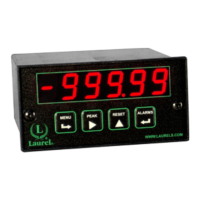- 31 -
4. Cold junction compensation (CJC) errors. Our meters do not use an actual cold
junction in ice water as the thermoelectric reference, but they calculate an offset by
measuring the voltage drop across the PN junction of a PNP transistor in close proximity
to the junction of the thermocouple wires and the meter terminals. The voltage drop
changes by -2.2 mV/°C. We specify the reference junction error as 0.5°C for an ambient
temperature of 10°C to 40°C. The signal conditioner board and PNP transistor are
calibrated as a system, so do not swap transistors. To minimize CJC errors, avoid air
turbulence around the PNP transistor.
5. Thermocouple wire errors. This the largest source of thermocouple reading errors, and
is caused by variations in the alloys found in commercial thermocouple wires. There are
variations from manufacturer to manufacturer, from batch to batch, and within batches.
Shown below are the American Limits of Error ASTM E230-ANSI MC 96.1. These are the
error limits imposed on manufacturers of thermocouple wire, not error limits applicable to
a meter used with ideal thermocouple wire. The “Special Limit of Error” applies to more
expensive “Special Limits of Error” (SLE) thermocouple wire.
The “Limit or Error” tolerance to be used is the listed temperature or percentage,
whichever is greater. Tolerances expressed in °F are 1.8 times those in °C. Percentage
based tolerances are to be computed from temperatures expressed in °C.
Tolerances in the above table apply to new, essentially homogeneous thermocouple wire,
normally 0.25 to 33 mm in diameter (30 to 8 AWG) and used at temperatures not
exceeding the upper temperature limits listed. If used at higher temperatures, these
tolerances do not apply. Thermocouples degrade with time, temperature, and exposure
to the environment.

